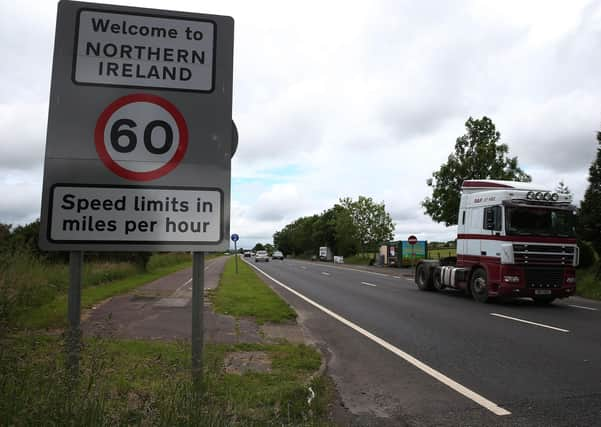Esmond Birnie: We cannot assume that North-South trade offsets the problems of the Northern Ireland Protocol


This part compensates for, possibly wholly compensates for, the extent to which the protocol undoubtedly hampered NI-Great Britain sales flows.
Earlier this week, the Irish Times (‘Imports from Northern Ireland to Republic up 77% since UK’s EU exit,’ August 17) noted how measured (by the Irish statistics authority, CSO) NI sales to the RoI had increased from 1 billion euros to €1.77bn comparing January-June 2020 with Jan-June 2021.
Advertisement
Hide AdAdvertisement
Hide AdAnd Republic of Ireland (RoI) sales to NI had apparently increased from €1.1bn to €1.57bn.


Little or nothing was said by way of qualifications on this data.
There are in fact four main reasons why such arguments should be treated with a lot of caution:
1. If what is going on is trade diversion such that old trading patterns east-west are being ripped up and new supply chains north-south put in place this may well represent higher costs to businesses alongside reduced choice to customers.
Advertisement
Hide AdAdvertisement
Hide AdEconomists would call this a ‘sub-optimal’ outcome. To make this point, imagine going back to a 1930s world with very high tariff barriers. Imagine these were placed around the island with NI and RoI constituting a single customs union. NI, say, would buy all its cars from kit manufacturers in the RoI and the RoI, say, would buy all its cigarettes and ships etc. from NI.
In this scenario cross-border trade would grow enormously precisely because trade with the world beyond the island had dropped but we would be much worse off in terms of higher costs, higher prices and reduced consumer choice.
2. Anyone trying to claim we are seeing a cross-border trade bonanza need to be very careful about the time period they use for the statistics.
Comparisons based on CSO (the south Irish statistical body) data for May or June 2021 compared to December 2020 or the Spring of 2020 will inevitably exaggerate the extent of trade growth — trade across most of the world slumped during 2020 given the pandemic. To be more accurate, we need to base our comparisons against what was happening prior to Covid, say 2019 or 2018.
Advertisement
Hide AdAdvertisement
Hide Ad3. Trade data are often very unreliable and subject to frequent and large revisions.
This is especially likely in this case. What the protocol may have done (unintentionally) is bring out of the woodwork cases where trade between RoI and NI as measured by the CSO was previously (wrongly) attributed to RoI and GB.
4. Counts of the number of goods vehicles (vans and lorries) moving across the Irish Border are not consistent with the apparently very high percentage growth in the value of North-South trade.
The movement of freight transport suggests at best modest volume growth between 2019 and 2021 and little growth 2020 and 2021.
Advertisement
Hide AdAdvertisement
Hide AdTaking the second, third and fourth of these points in more detail:
l Don’t consider trade growth since the depth of the Covid recession but instead use the base of either 2018 or 2019
Comparing the first five months of this year with 2020 RoI exports to NI grew by 38.5% and NI exports to RoI grew by 77.2% (these CSO data include the revisions to data post January 1 2021 discussed below). Comparing January-May 2021 with January-May 2019, a rather more realistic comparison given the general recession in economic activity associated with Covid in 2020, the growth rates were 18.8% and 51.5% respectively.
Such growth rates are still substantial but we should consider the possibility that the trade data will be further revised and the contrary indications coming from the available data on cross-border freight vehicle movements.
l Trade data are liable to substantial revisions
Advertisement
Hide AdAdvertisement
Hide AdSince the start of this year the RoI statistical body CSO has been collecting trade data relating to RoI-NI on a different basis than that relating to RoI-GB.
Given that NI remains part of the single market the trade flows between NI and the RoI continue to be measured through Intrastat surveys and VAT returns. RoI-GB trade flows are now measured through customs declarations.
Trading conditions under the protocol have led to NI firms using their own VAT identifications and in some cases trade which was previously (incorrectly) recorded by CSO as RoI-GB is now recorded as RoI-NI. CSO (July 15 2021) has therefore very substantially revised upwards its measure of NI-RoI exports for both 2020 and 2019.
Given that the pre-Brexit protocol ‘baseline’ level of North-South trade is now known to be much higher than was previously thought, by implication the percentage growth between 2020 and 2021 is lower.
Advertisement
Hide AdAdvertisement
Hide Adl Data on freight traffic across the Irish Border suggests much lower growth in trade
Since the early 2010s the operator of the public roads system in RoI, Transport Infrastructure Ireland (TII), has had “counter” devices in place just south of 15 of the main Border road crossings. This network of counters produces data for NISRA on monthly crossings (in both directions). When the recent CSO data on trade values is contrasted with the NISRA data on road freight movements, the latter suggests much more limited trade growth:
Comparing the first five months of this year with 2020 RoI exports to NI grew by 38.5% and NI exports to RoI grew by 77.2% (these CSO data include the revisions to data post January 1 2021 discussed above).
Comparing January-May 2021 with January-May 2019, a rather more realistic comparison given the general recession in economic activity associated with Covid in 2020, the growth rates were 18.8% and 51.5% respectively.
Advertisement
Hide AdAdvertisement
Hide AdHowever, total goods vehicle traffic at the main crossing points grew by ‘only’ 16.8% comparing 2021 and 2020 and actually fell between 2019 and 2021.
There are some possible limitations relating to the Transport Infrastructure Ireland/NISRA traffic counts data.
The data do not include crossings over and above the 15. That said, the 15 are major crossings, so this should be a reasonable ‘sample survey’ of total North-South goods traffic.
Some goods could be carried between NI and the RoI by ship or plane. But the non-road proportion of total goods traffic is likely to be small. And, of course, ‘transporter teleporters’ only exist in science fiction.
Advertisement
Hide AdAdvertisement
Hide AdWe are still left with the problem how can so much extra freight be moving between the two economies without much if any increase in movements of lorries and vans?
Admittedly, the TII/NISRA data are a simple count of number of vehicles and as such cannot capture any variation in the size of the vehicles or, indeed, the extent to which they are loaded (filled to a greater extent of full capacity or carrying goods of greater value per unit weight or unit of volume).
Some such variations might explain some of the very rapid growth of trade value indicated by CSO. And it may be significant that the number of HGV-rigid (likely to the largest lorries) held up best and then grew most but, that said, even here the 2019-2021 growth was only 2%.
Perhaps the most likely conclusion is that the most recent trade data is still exaggerating the real extent of growth in North-South trade
Advertisement
Hide AdAdvertisement
Hide AdTime will tell, especially in terms of the publication of more (and further revised) data on trade and cross-border activity. We will eventually get data on NI’s trade from the NI/UK statistical agencies.
In the meantime, it would be hazardous for policy makers to assume that growing North-South trade has counter-balanced all of the economic difficulties caused by the protocol.
• Dr Esmond Birnie is senior Economist Ulster University Business School. The original article he wrote for the school includes tables of supporting data
——— ———
A message from the Editor:
Thank you for reading this story on our website. While I have your attention, I also have an important request to make of you.
Advertisement
Hide AdAdvertisement
Hide AdWith the coronavirus lockdown having a major impact on many of our advertisers — and consequently the revenue we receive — we are more reliant than ever on you taking out a digital subscription.
Subscribe to newsletter.co.uk and enjoy unlimited access to the best Northern Ireland and UK news and information online and on our app. With a digital subscription, you can read more than 5 articles, see fewer ads, enjoy faster load times, and get access to exclusive newsletters and content. Visit https://www.newsletter.co.uk/subscriptions now to sign up.
Our journalism costs money and we rely on advertising, print and digital revenues to help to support them. By supporting us, we are able to support you in providing trusted, fact-checked content for this website.
Ben Lowry
Acting Editor